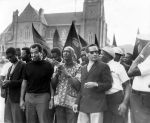He stood before the bulldozers that erased the lower Hill District with Byrd Brown and Jimmy Joe Robinson, saying, “no further.” He led the marches and protest that culminated in more than 1,500 Blacks gaining union jobs they had been denied for decades. And along the way he met and befriended people of all political stripes, from Yasser Arafat and Jimmy Carter to Dick Thornburgh and George H.W. Bush. And always his challenge was the same—help me help my people.
 |
| CIVIL RIGHTS WARRIOR—Nate Smith, flanked by Rev. Jimmy Joe Robinson, left, and Byrd Brown prepares to march Downtown from Freedom Corner to demand equal employment rights.
|
“When he did what he did, Nate wasn’t the head of anything. He wasn’t educated, but he moved the city and the country,” said Black Political Empowerment Project founder Tim Stevens.
Smith died March 31 at Cedars Community Hospice in Monroeville following a long bout with dementia. He was 82.
Louis “Hop” Kendrick called Smith one of the giants of the Civil Rights Movement.
“He was one of the driving forces in the days of the Movement,” said Kendrick. “And he was a true civil rights warrior because he made real contributions to improve people’s lives.”
Mary Louise Burns, now 87, said Smith helped her and her late husband Art get their Southern Platter restaurant started in Homewood.
“He told us where to go and who to see to cut through the red tape, and I’m sure he did that for others in the Black community,” she said. “And he would always come in for breakfast and make sure everything was going okay. He did a lot of things like that.”
Erica Peiffer who spent five years working on a documentary film biography on Smith, “What Does Trouble Mean? Nate Smith’s Revolution,” said she aspires to be like him because he was, “one of the most passionate people I’ve met.”
“He layed down in front of a bulldozer,” she said. “He laid down his whole life to help others.”
Smith, who had a habit of doing what he wanted to, despite any obstacles, joined the U.S. Navy at age 12—because he liked the song “Anchors Aweigh”—and faced such rampant discrimination that he literally fought for his survival. As such, when the Navy discharged him after learning his real age, he emerged from the service as a skilled boxer and pursued a career in the sweet science. He was able to parlay that skill into a career in the construction trades.
“Nate knew he could only do boxing for so long, so he decided he was going into the construction unions,” said his longtime confidant and business partner Ed Meeks. “And that’s where the real fighting started.”
In 1951, booked on the undercard of the sold-out Ezzard Charles, Jersey Joe Walcott heavyweight championship, he offered some union officials tickets in exchange for a union card. Thinking Smith wouldn’t last, they agreed. He lasted 55 years.
And when the construction boom of the late 1960s started, and Blacks weren’t working on the U.S. Steel Building or Three Rivers Stadium, Smith was there, marching and protesting.
Following what became known as the “Black Monday March” in 1969, President Richard Nixon sent Labor Secretary Bill Usery to Pittsburgh to mediate disputes among the unions, the Black construction coalition and politicians.
The union bosses said they’d hire Black machine operators—but couldn’t find any; Smith said he would train them—and he did.
Out of this came the Pittsburgh Plan to integrate trade unions, which was copied across the country. Smith’s Operation Dig, served as the construction trades training and employment vehicle for the plan. For his achievements in civil and labor rights, Smith was featured in Jet and Ebony magazines, as well as the New York Times, the Washington Post and the Wall Street Journal.
Smith’s battles also inspired other Black tradesmen, like former NAACP Penn Hills President Oliver Montgomery, who was instrumental in integrating the United Steel Workers.
After moving to Pittsburgh to join the union’s research department as an associate and financial analyst in 1969, Montgomery almost cost himself the position by intentionally missing his first interview—to protest against the union’s largest contractor.
“The first day I got here, I postponed my interview to go march with Nate Smith, who was protesting the lack of Black construction workers on the U.S. Steel Building project,” he said. “I was ready to go back to Youngstown after that, but the union told me to stick around.”
Over the last two decades, Smith and Meeks worked to translate Smith’s legacy of labor integration and activism into a classroom-oriented setting promoting construction trade careers called Renaissance III 2000 Inc.
Meeks said it was hard to see Nate in his final days, but “he still had a strong grip.”
Smith’s wife of 63 years, Minnie, died in February. He is survived by a son, Nate Smith Jr. and a daughter, Renee Smith Clark, three grandchildren and four great-grandchildren.
Visitation is scheduled for April 7, from 2-7 p.m. at Rapp Funeral Home, 10940 Frankstown Rd., Pittsburgh 15235. Services will be held at 10 a.m. the following morning at the Church of the Ascension, 4729 Ellsworth Ave., Pittsburgh 15213.
In lieu of flowers, the family requests donations be made to The Nate Smith Documentary Project at Robert Morris University, 6001 University Blvd., Moon Twp. 15108.